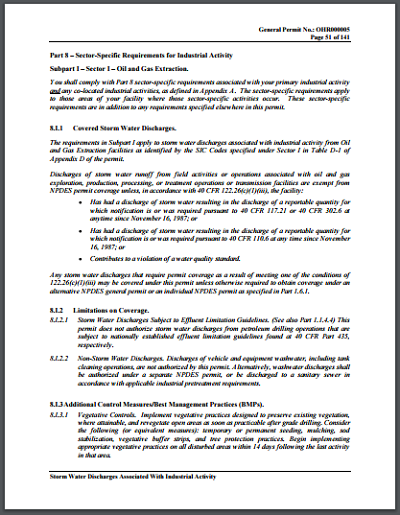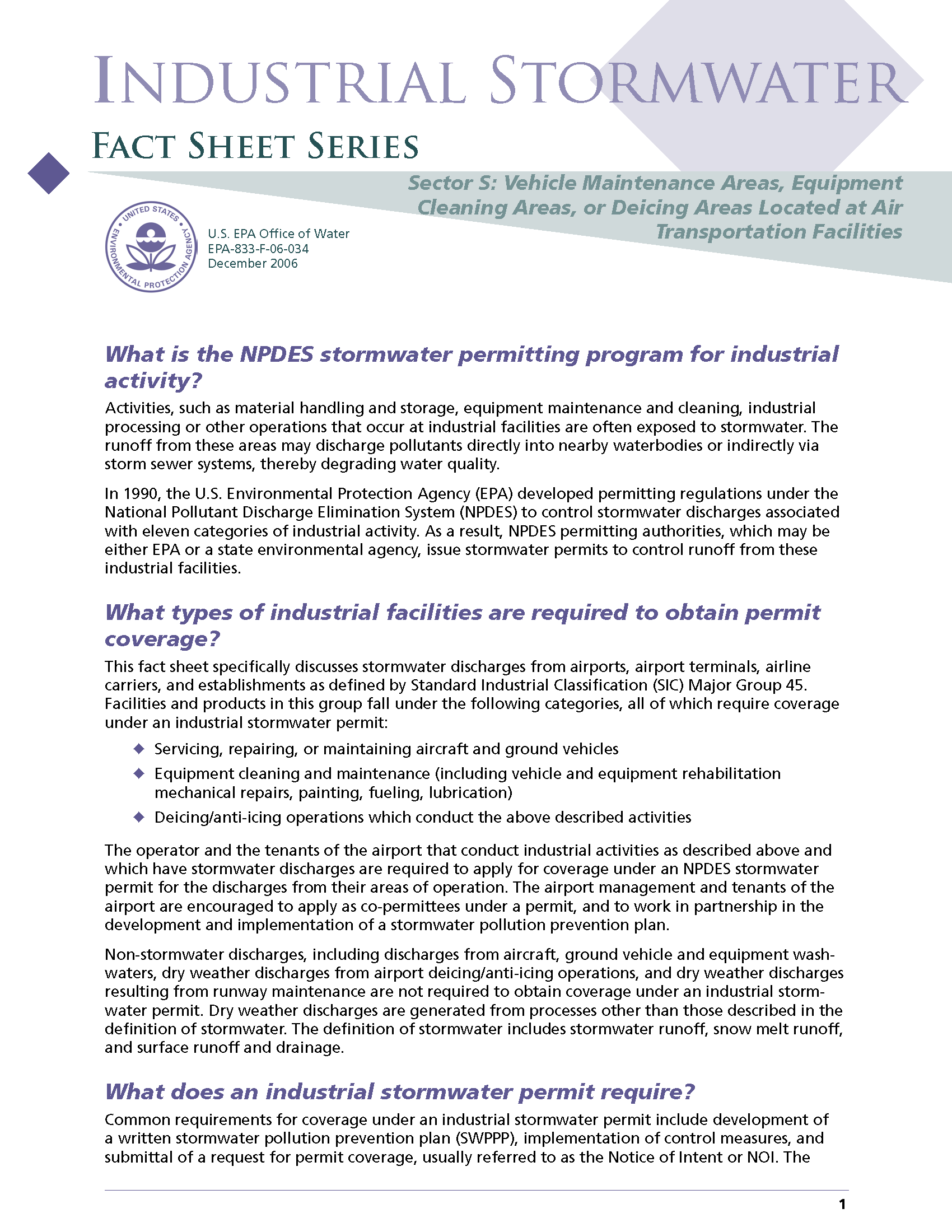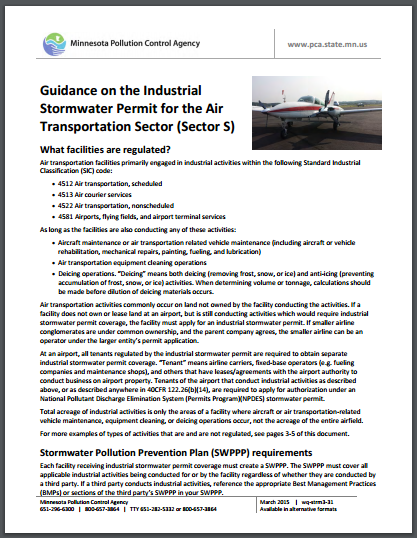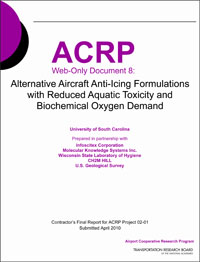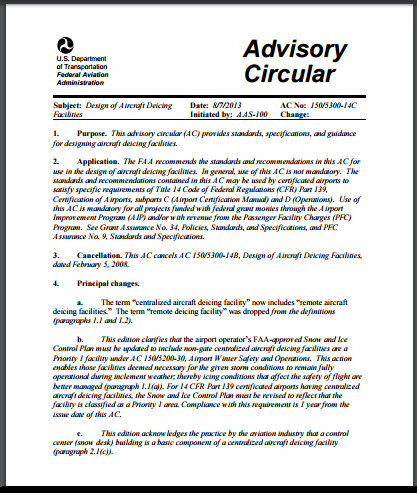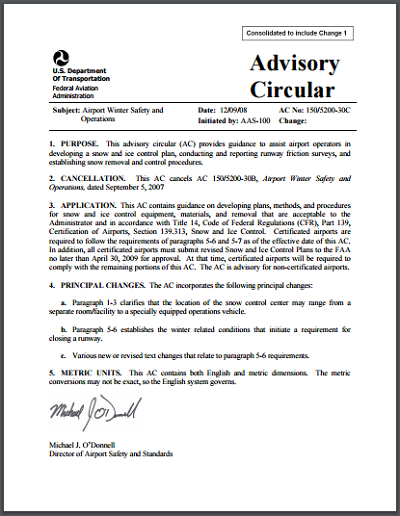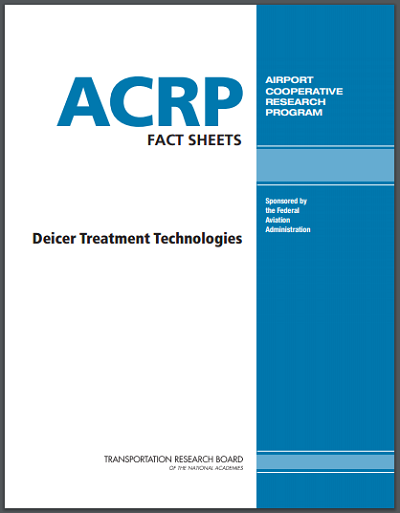< Return to Stormwater Regulations & Permitting
Airport Stormwater Permitting Overview
This page presents an introduction and overview of stormwater permitting programs and topics that may apply to an airport. Other regulatory topic summaries in this series go into greater detail about the different stormwater permitting programs.
What is the stormwater pollution problem and how did the government address it?
Stormwater from urbanized and industrial areas can contain significant quantities of pollutants that discharge into waters of the United States. Human activities and land use contribute pollutants to stormwater discharges that can greatly impact receiving waters. Congress recognized such concerns, passing the 1987 amendments to the Clean Water Act (CWA) that added Section 402(p), a provision that directed the Environmental Protection Agency (EPA) to establish phased National Pollutant Discharge Elimination System (NPDES) requirements for certain stormwater discharges.
EPA’s Phase I regulations permit discharges from medium and large municipal separate storm sewer systems (MS4s) serving a population of 100,000 or more, as well as certain categories of stormwater “associated with industrial activity,” including certain activities that occur at airports and construction activity disturbing greater than 5 acres (55 Fed. Reg. 47,990, November 16, 1990). EPA’s Phase II expanded the stormwater program to include small and non-traditional MS4s and construction activity disturbing from 1 to 5 acres (64 Fed. Reg. 68,722, December 8, 1999).
For more information regarding the scope of the NPDES stormwater program, search the internet using these keywords: EPA NPDES stormwater program.
While the CWA stormwater provisions and EPA’s regulations address many types of stormwater discharges, other impacted stormwater discharges that are not specifically spelled out in EPA’s regulations are exempt from permitting unless designated by a permitting authority for individual permitting.
What airport industrial pollutant sources must get stormwater permits?
The types of raw materials, production processes, and treatment technologies used at industrial facilities, and the pollutants discharged in stormwater from industrial facilities, vary widely and are dependent on the type of industry and specific facility characteristics. These operations, however, generally are carried out within a clearly defined area. Thus, to minimize the impact of stormwater discharges from industrial facilities, the NPDES program includes an industrial stormwater permitting component.
Sector S, Air Transportation Facilities, is one of the 11 categories that EPA identifies as generating “stormwater associated with industrial activity” and requires discharges be authorized under an NPDES industrial stormwater permit. Sector S requirements apply to stormwater discharges from those portions of an airport where vehicle maintenance, equipment cleaning operations, or deicing operations are conducted. See 55 Fed. Reg. 48,063, November 16, 1990.
How are stormwater discharges associated with construction activities permitted?
EPA and most NPDES-authorized states have issued NPDES general stormwater permits for discharges associated with construction activity (typically called “construction general permits” or “CGPs”) that are separate from the industrial stormwater general permits. This distinction is due to the unique issues associated with temporarily active construction operations that disturb soils. CGP coverage is required for all construction activity that results in land disturbance that is equal to or greater than 1 acre. Often, CGPs will have more significant requirements for active construction operations that equal or exceed 5 acres.
How are MS4 stormwater discharges regulated?
Medium and large MS4 operators are required to submit comprehensive permit applications and are issued individual permits. These permits rely on various municipal stormwater management programs designed to control pollutants to the maximum extent practicable (MEP) and to effectively prohibit non-stormwater discharges to the municipal system. EPA has not precisely defined MEP (which also is not defined in the CWA) so as to allow maximum flexibility in MS4 permitting to optimize reductions in stormwater pollutants on a location-by-location basis.
EPA’s Phase II MS4 regulations require small MS4s to develop programs to address six minimum control measures that include best management practices (BMPs) and measurable goals for each BMP. Phase II MS4 authorization is obtained through general permits, individual permits, or as “co-permittees” within an existing (although likely modified) Phase I MS4’s individual permit (64 Fed. Reg. 68,722, December 8, 1999).
The term “MS4” also refers to more than “traditional” municipally owned storm sewer systems. Other examples include “non-traditional entities” such as state departments of transportation, airports, universities, local sewer districts, hospitals, military installations, post offices, prisons, and irrigation districts. In the case of airports, permitting authorities may require the airport to obtain an MS4 permit for non-industrial stormwater, or to work with the neighboring MS4s to control such non-industrial stormwater.
What type of NPDES permits are available for the various types of regulated stormwater discharges?
Generally, EPA- or state-issued general permits regulate stormwater discharges from industrial, construction, and Phase II municipal sources. Phase I municipal sources usually are issued individual permits. A permitting authority may choose to issue an individual stormwater permit where it determines that the requirements of a general permit are not adequate to control stormwater pollutants. The impact of deicing operations on stormwater discharges is the most common justification for an airport to be issued an individual permit. All regulated sources can request individual in lieu of general permits, but, typically, the permit conditions are identical if not more onerous than available general permits. However, in some cases, stormwater conditions may be incorporated into a comprehensive individual NPDES permit for an entire facility.
Who issues stormwater NPDES permits?
Under the CWA, states may seek authorization from EPA to issue NPDES permits. To date, all but four states have become authorized. EPA remains the permitting authority in Idaho, Massachusetts, New Mexico, New Hampshire, the District of Columbia, territories, federally owned facilities/areas, and most Native American territories.
For specific state or territory stormwater permitting information, search the internet using these keywords: EPA NPDES state program information.
* * * * * * *

